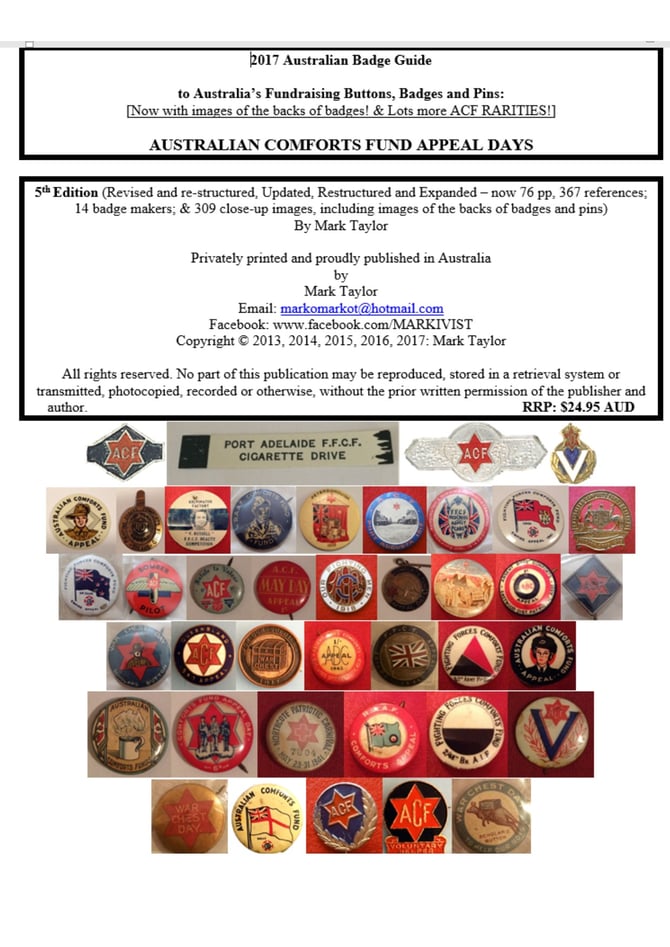
2017 Australian Comforts Fund - Australian Badge Guide
We are proud to present to you our 5th edition of this, one of our most popular titles - Australian Badge Guide – the 2017 Australian Comforts Fund. That’s right we have been refining this guide since 2012 and genuinely believe this to be one of our best yet.
We hope you like it.
Some 76 pages in length, with 367 references, and some 309 images, this makes this Australian Badge Guide a must have for serious collectors and those who are just fascinated by Australia’s social and cultural history particularly in relation to the Great War and World War Two. There is also information about 14 badge makers who manufactured badges, buttons and pins for the ACF. Who knows, perhaps you too will become an even greater badge enthusiast?
Interestingly, The Australian Comforts Fund (ACF) was originally formed on 24 August 1916 to raise money for items to be sent to the troops fighting for the Empire in World War One. The ACF also ran small canteens near the front lines that served food supplies and provided primus stoves, clothes, sporting equipment, games, newspapers and magazines. The ACF also ran a residential and recreational club for troops on leave in London called the AIF and War Chest Club. The ACF was formed from a number of Australian State-based patriotic organisations that had been individually formed at the beginning of the war. The motto was "Keep the Fit Man Fit", in order to distinguish its work from that of the Australian Red Cross, and such comforts provided were seen as a sound investment in the morale of the fighting forces, with the comforts being provided to the troops as close as practicable to the frontline fighting. Fundraising badges, buttons and pins often featured the gold or red six-pointed star to distinguish the ACF from the various other patriotic organisations raising funds during the war. This ACF “branding” was also applied to all shipments and packages of goods.
With the cessation of fighting on the western front, the ACF officially ceased its fundraising operations on 16 April 1920, but was reformed with the outbreak of the Second World War. A significant majority of Australia’s volunteers during World War II worked for either the Australian Red Cross or the Australian Comforts Fund (the two largest wartime fundraising organisations in the country). Both these organisations were officially recognised by the Australian Government to support and assist Australia's servicemen and women. The ACF was run largely by women volunteers who undertook the majority of administrative and manual work required to raise funds from the Australian community at the time. According to The University of Melbourne website, the Australian Comforts Fund was formed after a meeting of delegates of various State funds on the 9 January 1940 in Melbourne. The aim of the meeting was to provide better coordination than that which had occurred during World War I. Once again, the function of the Fund was to provide services for fit and healthy serving members of the Australian Forces (men and women) within, and outside, Australia. It was decided that the Australian Comforts Fund would be under the control of an Australasian council composed of three delegates from each State, with its headquarters in Sydney, with each State to be a division of the fund, and each district (within the State where a committee had been set up) was to be a branch. Comforts fund commissioners would also have the authority to go abroad with the troops to control the whole of the comforts consignment sent from Australia, and supervise their distribution. These men would act in an entirely honorary capacity and receive no pay or salary. Mr R. Godward, of Sydney, a returned soldier, was selected as chief commissioner.
The function of the Australian Red Cross was once again to be the care of the wounded, sick and prisoners of war, and both the ACF and the Australian Red Cross were officially accredited to the Forces. Three other bodies came to be officially recognised - the YMCA, the Salvation Army and the YWCA (the last organisation was formed some time later, when increasing numbers of women in the Forces called for a separate organisation to care specifically for their needs). Many fundraising activities were coordinated across these different bodies for the joint benefit of these organisations and their fundraising aims. It should also be noted that these patriotic Funds would co-operate in their fundraising activity. For example, the executive of the Fighting Forces Comforts Fund and the Red Cross Emergency Committee were reported as showing their sympathy for the Sailors and Soldiers' Distress Fund by deciding that, until after Anzac Day, they would make no new appeals for public donations.
As was the case in World War I, the six-pointed ACF Red Star emblems became a defining feature of letterheads, posters, programmes and aid parcels. The Age newspaper, dated 14 February 1940, reported that the Australian Comforts Fund would use the same emblem (the red six-pointed star with the initials A.C.F. inside) as it had for the First World War.
 Cart
Cart  Checkout
Checkout